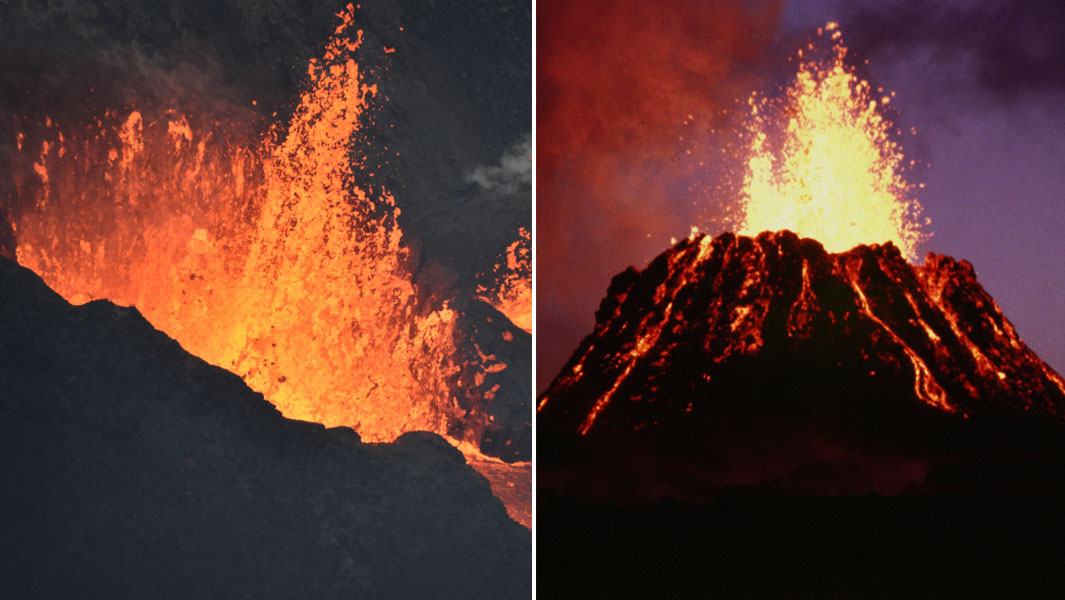Kīlauea: The explosive home of Hawaii’s volcano goddess

Imagine what it must be like to have to coordinate your life around an erupting volcano.
That’s exactly what locals on Hawaii’s Big Island have been doing for decades.
That’s because their volcano Kīlauea is the most active volcano in the world and has been continuously erupting since 1983.

Since 1918, Kīlauea's only prolonged period of rest was an 18-year pause between 1934 and 1952.
Locals have learned to live with the volcano disrupting their lives, re-routing their daily journeys as lava spews and cuts off highways.
Located on the southeastern part of the island of Hawaii, the volcano has been discharging lava at a rate of 5 m³ (7 yd³ or 176 ft³) per second.
Kīlauea is an elongated dome made up of lava eruptions from a central crater and from lines of craters which extend along east and southwest rifts.
The volcano’s 4,090-foot (1,250-metre) summit has collapsed and formed a caldera, a broad shallow depression measuring nearly 3 miles (5 km) long and 2 miles (3.2 km) wide with an area of more than 4 square miles (10 square km).
In the caldera, the main crater of the volcano was formed.

The crater is called Halema'uma'u, a Polynesian name meaning "house of fern."
For many years, Kīlauea was thought to be a satellite of its massive neighbour, Mauna Loa, rather than a separate volcano.
However, research over the past few decades shows that Kīlauea has its own magma-plumbing system, extending to the surface from more than 37 miles (60 km) deep in the earth.
Kīlauea is also said to be home to Pelehonuamea, the Hawaiian volcano goddess.
Traditional tales and songs tell the stories of many eruptions provoked by an angry Pele before the first European, the missionary Rev. William Ellis, saw the summit in 1823.
Pele sends rivers of lava down the mountainside, adding more than 70 acres of new land to the southeastern coast since 1983.
Tales of encounters with Pele include her face mysteriously appearing in photos of the lava lake within the crater or molten lava flows.
Pele is deeply respected among the people of the islands.
Since 1952, Kīlauea has erupted dozens of times and from 1983 to 2018, its eruptive activity was continuous along the volcano’s East Rift Zone.
The long-term eruption from the East rift zone that began in 1983 has produced lava flows covering more than 38 sq miles (100 sq km), destroying nearly 200 houses and adding new coastline to the island.
From May to July 2018, a huge eruption on the East Rift Zone of Kīlauea relieved magmatic pressure under Halemaʻumaʻu, causing the crater to collapse and expand from 280 feet (85m) deep and 0.5 miles (0.8 km) wide to 1600 feet (487m) deep and 1.5 miles (2.4 km) wide.

The eruption destroyed more than 700 homes and devastated residential areas.
Since the 2018 eruption, Kilauea has been erupting sporadically.
Then in 2019, USGS Hawaiian Volcano Observatory scientists confirmed that a lake of water was growing inside the Halemaʻumaʻu crater.
Never before had water been visible at the summit of Kīlauea in the form of a lake.
But on 20 December 2020, the ten-story deep lake boiled off when lava re-entered Halemaʻumaʻu.
The eruption continued for another few months, though activity steadily decreased.
On 26 May 2021, the Hawaiian Volcano Observatory announced that Kīlauea was no longer erupting.
The Hawaiian Volcano Observatory began to record increased earthquake activity and changes in ground deformation patterns at Kīlauea's summit on 29 September 2021.
An eruption began at 3:20 p.m. local time when several fissures opened within Halemaʻumaʻu crater in Kīlauea's summit caldera.
The eruption paused on 9 December 2022 before eruptive activity within Halemaʻumaʻu resumed on 5 January 2023.
The Halema'uma'u eruption ended 61 days later on 7 March 2023.
Kilauea’s most recent eruption spanned between 5 January 2023 and 7 March 2023, shooting lava as high as 164 feet into the air.
As of 21 April 2023, Kīlauea is no longer erupting, and lava or night-time glow is visible from any overlooks.
However, given Kīlauea’s history, another eruption may be imminent.
Hawaiian and explosive activity is expected to make Kīlauea taller, build up its rift zones, and fill and refill its summit caldera.
Want more? Follow us across our social media channels to stay up-to-date with all things Guinness World Records! You can find us on Facebook, Twitter, Instagram, TikTok, LinkedIn, and Snapchat Discover– including our new Guinness World Records Extreme channel.
Don’t forget, we’re also on YouTube!
Still not had enough? Follow the link here to buy our latest book, filled to the brim with stories about our amazing record breakers.


